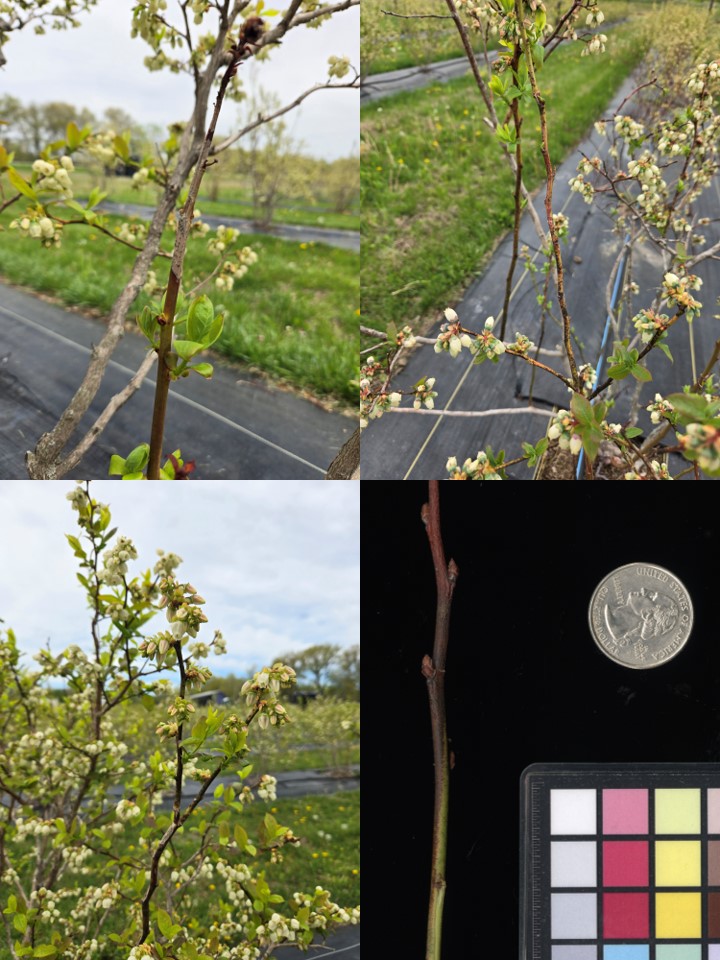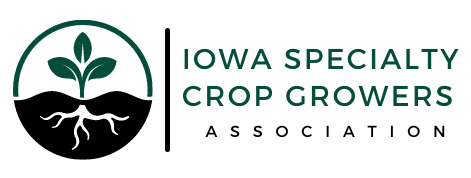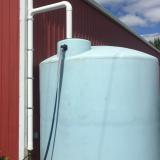Blueberries are a resilient crop that has few disease concerns regarding cankers. Canker causing diseases typically cause stems and shoots to decline or die. Culturally, renewal pruning can prevent a buildup of canker causing fungi by removing the oldest stems yearly. However, when growing blueberries when the soil pH is towards the top of the limit (>5.5 pH value), the stress level of the plant increases. This increase in abiotic stress can open the blueberry plant up for infection events from opportunistic pathogens. Another management issue for blueberry plant enthusiasts is that opportunistic pathogens are not always considered in spray guides or have little management information since they are so environmentally dependent.
There are four canker causing fungi that are of concern in the Midwest:

Phomopsis Canker (Diaporthe/Phomopsis spp.)
- The Phomopsis canker is the most common canker disease on blueberries. Symptoms include small reddish lesions on young shoots that expand into sunken, gray or tan cankers. In severe causes, shoot tips can flag and die with a sudden browning of leaves mid-season. Since cankers often develop just below a pruning wound or bud, there are some environmental conditions that favor disease, particularly wet spring weather and pruning during rainy periods. Winter injury and mechanical damage from late harvested cultivars can also increase susceptibility.
Fusicoccum Canker (Fusicoccum putrefaciens / Godronia cassandrae)
- Fusicoccum canker is the second more common canker fungi on blueberry. Symptoms include reddish to brown elliptical cankers on 1- to 2-year-old wood. Buds near infected areas often fail to open and if they do in early spring there might be leaf wilting and shoot dieback. This pathogen needs a wound to enter and is typically spread by rain through pruning wounds.
Botryosphaeria Canker (Botryosphaeria spp.)
- Botryosphaeria Canker is one of two canker diseases that are almost always associated with abiotic stress rather than necessarily opportunity. It shows up as dark large cankers on older wood and typically we’ll caused alarm as its mean symptom is sudden shoot wilting after drought stress. The main avoidance for this disease is to reduce any abiotic stress especially drought stress in blueberry plantings.
Neopestalotiopsis Canker (Neopestalotiopsis rosae)
- Neopestalotiopsis canker is a relatively new canker for blueberries in the United States/Midwest. Symptoms typically include small cancers with gray margins and black spores in the middle. This opportunistic pathogen seems to tend to like blueberry bushes that are being grown in soil towards the higher end of the pH scale. The main symptom associated with this canker is sudden shoot wilting in late season. since this pathogen is so new, there is not much known about management or timing and more work is being done on this new blueberry disease.
Management strategies for blueberry canker diseases in general
- Pruning for Prevention
- Timing: Prune during dry weather, ideally in late winter or early spring.
- Technique: Remove and destroy symptomatic canes. Cut several inches below visible cankers.
- Tool Sanitation: Disinfect pruning tools between cuts using alcohol or a 10% bleach solution.
- Reduce Plant Stress
- Avoid overcropping young bushes.
- Maintain consistent irrigation—drought-stressed plants are more susceptible.
- Fertilize based on soil and tissue test results to avoid excess nitrogen, which can promote succulent growth prone to infection.
- Improve Air Circulation
- Maintain appropriate spacing between bushes and rows.
- Control weeds and sucker growth to allow air movement through the canopy.
- Fungicide Applications
- Fungicides are not consistently effective alone but may help when used protectively:
- Apply during periods of high risk (e.g., immediately after pruning or following hail).
- Products with captan, ziram, or prothioconazole may provide suppression; check the Midwest Fruit Pest Management Guide efficacy and PHI. (https://ag.purdue.edu/department/hla/extension/sfg-sprayguide.html)
- Scout Regularly
- Monitor fields in early spring and mid-summer for signs of shoot dieback or cankers.
- Mark infected plants for follow-up pruning.
When to replant
In cases of severe and chronic infection, especially in borderline pH level or poorly drained soils, removal and replanting may be the best long-term solution. Choose disease-free nursery stock and adjust the soil pH if possible, and plant on a raised bed using acidic organic matter like pine bark.
Summary
Blueberry canker diseases are best managed through sanitation, stress reduction, and timely scouting. While fungicides can be part of an integrated program, cultural practices remain the foundation of control. A healthy, well-maintained bush is the best defense against canker development and spread.
–Acreage Living Newsletter, Iowa State University Extension & Outreach

